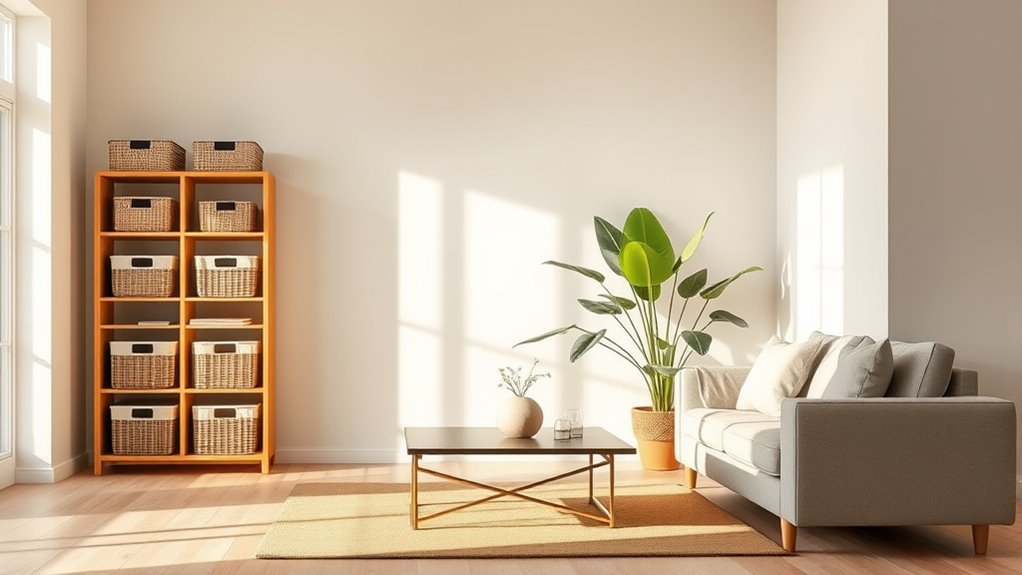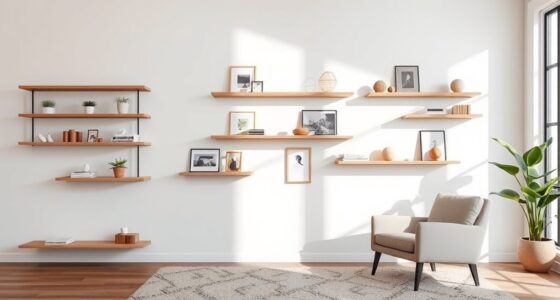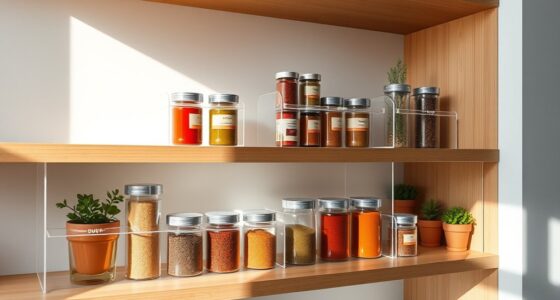I've found three essential decluttering items that truly saved my sanity: color-coded bins for sorting, a timer for focused sessions, and checklists to keep me on track. The bins help me group similar items, making decisions easier. Using a timer creates a sense of urgency, keeping me motivated. Finally, my checklists remind me of my progress and goals. These tools have transformed my space, and there's more to explore on how to maintain that clutter-free environment.
Key Takeaways
- Color-coded bins and labels simplify sorting items, making it easy to group similar belongings and enhance the decluttering process.
- Checklists help maintain focus and motivation during decluttering, ensuring that tasks are completed systematically.
- Timer techniques like Pomodoro create urgency, boost productivity, and minimize procrastination while tackling decluttering tasks.
- Storage solutions that enhance visibility ensure items are easily accessible and encourage regular use, preventing clutter accumulation.
- The 20/20 rule aids quick decision-making by determining if an item can be replaced for under $20 and within 20 minutes, simplifying retention choices.
The Sentimental Persons Guide to Decluttering

If you're someone who finds it hard to part with belongings due to emotional attachments, then "The Sentimental Persons Guide to Decluttering" is exactly what you need. This book helped me confront my clutter without feeling overwhelmed. It offers practical strategies that resonate with my struggles, like grouping similar items together, which simplifies the decision-making process. I learned to let go of the guilt tied to gifts and heirlooms, realizing they shouldn't be obligations. Readers, including myself, appreciate its approachable style, making decluttering feel achievable and motivating. It's a must-read for anyone wanting a more minimalist lifestyle.
Best For: Individuals who struggle with emotional attachments to possessions and seek practical guidance for decluttering without feeling overwhelmed.
Pros:
- Offers relatable strategies for sentimental individuals, making the decluttering process more approachable.
- Encourages a shift in perspective regarding emotional attachments to items, reducing feelings of guilt.
- Motivational tone inspires readers to take action and tackle clutter effectively.
Cons:
- Some may find the information presented to be basic or lacking in depth.
- The focus on emotional aspects may not resonate with everyone, particularly those less attached to their belongings.
- May require additional resources for those needing more advanced decluttering techniques.
Decluttering Mastery: 3 Books in 1
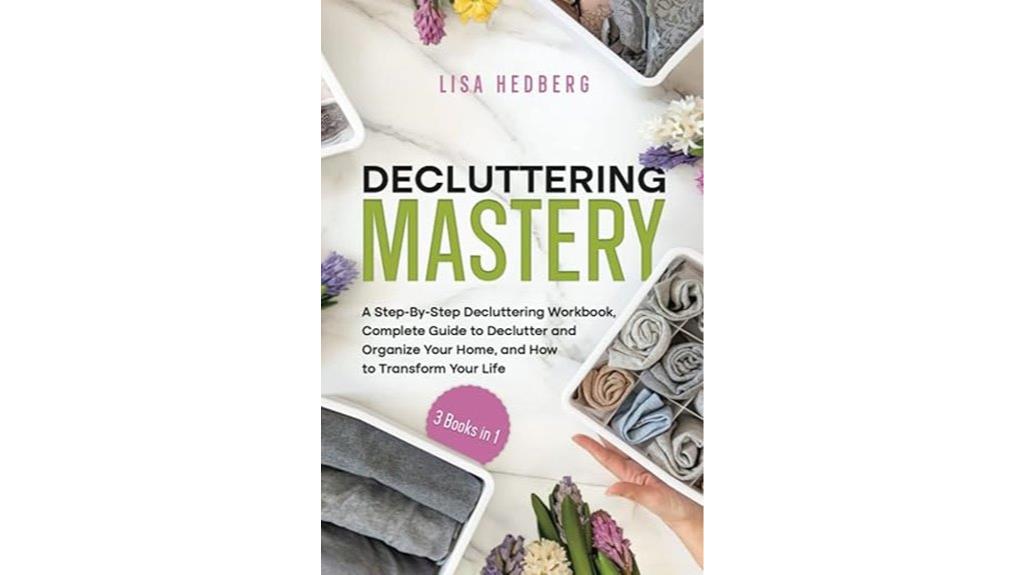
"Decluttering Mastery: 3 Books in 1" is perfect for anyone feeling overwhelmed by their clutter, especially if you're looking to transform not just your space but your mindset. This thorough guide offers a step-by-step workbook and practical strategies like the command-z solution and the 20/20 rule. I found it engaging, almost like having a supportive friend by my side. The author's insights on emotional attachment to items really resonated with me, encouraging self-reflection. While some visuals would enhance the experience, this book is a valuable resource for anyone ready to reclaim control and create a harmonious, clutter-free environment.
Best For: Individuals feeling overwhelmed by clutter who want to transform both their living spaces and mindset through practical decluttering strategies.
Pros:
- Engaging and motivational writing style makes the reader feel supported throughout the process.
- Provides a variety of practical strategies and tools to tackle decluttering in manageable steps.
- Encourages personal reflection on emotional attachments to belongings, fostering a deeper understanding of the decluttering journey.
Cons:
- Some readers feel the inclusion of visuals, like before-and-after photos, would enhance the experience.
- Minor formatting issues may detract from the overall presentation of the book.
- While thorough, some may find the step-by-step approach a bit overwhelming if they prefer a more straightforward method.
Decluttering Advice: Easy Ways to Reduce Stress and Declutter Your Home
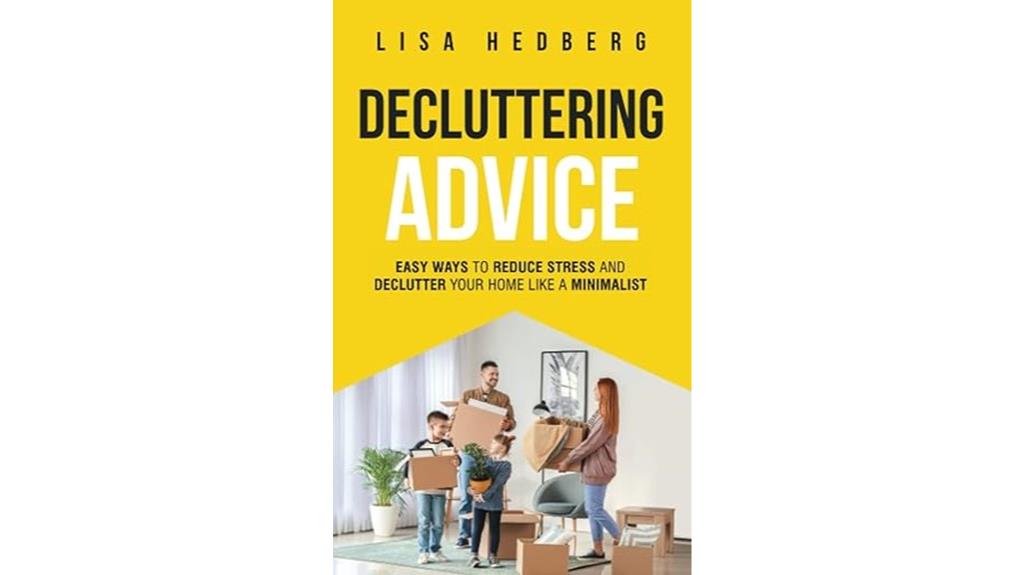
For anyone feeling overwhelmed by the chaos of their living space, "Decluttering Advice: Easy Ways to Reduce Stress and Declutter Your Home" is a perfect choice. Lisa Hedberg's practical guide simplifies the decluttering process, encouraging you to tackle one room at a time. You'll find clear tasks that keep you organized and focused, making it easier to decide what to keep or let go. I appreciated the relatable experiences shared, which inspired me to let go of unwanted items. With actionable plans and motivating insights, this book truly helps create a more peaceful, organized home. It's a must-read for anyone struggling with clutter!
Best For: Anyone looking to simplify their lives and reduce clutter in a structured and supportive way.
Pros:
- Provides clear, step-by-step instructions for decluttering one room at a time.
- Offers relatable personal experiences that inspire readers to let go of unwanted items.
- Includes actionable plans and motivational insights for maintaining an organized home.
Cons:
- Some readers suggest the format could be improved with bullet points and pull-out quotes for easier navigation.
- There is a desire for more original ideas, as some content overlaps with existing decluttering literature.
- A more visual guide may appeal to those who prefer quick and actionable advice.
Factors to Consider When Choosing These Decluttering Items That Will Rescue Your Sanity.

When I think about decluttering, I consider how my personal attachments to items can really affect my choices. It's also essential to recognize the emotional impact clutter has on my space and well-being. By tackling each room with practical organizing tools and visualizing my decluttering goals, I can make this process much smoother.
Personal Attachment to Items
Many people find it tough to let go of items that hold emotional significance. I get it; memories tied to gifts, family heirlooms, and important moments can make decluttering feel like a loss. When I consider discarding something given to me, guilt often creeps in, making me feel obligated to keep it, even if it serves no purpose. But I've learned that gifts shouldn't become burdens. Shifting my mindset helps me see decluttering as a chance to create space for new memories. Engaging in self-reflection about the utility of each item empowers me to make better decisions, leading to a more organized and peaceful living space. It's about prioritizing my well-being over sentimentality.
Emotional Impact of Clutter
Although it's easy to overlook, the emotional impact of clutter can truly affect our mental well-being. I've noticed that a cluttered space often heightens my anxiety and stress, making it hard to focus. It's tough to confront the guilt tied to letting go of items that hold memories or relationships. Studies show this chaos can even lead to depression, stripping away my sense of control. Yet, decluttering can be therapeutic; it allows me to process emotions linked to my belongings, leading to relief and empowerment. I've learned that gifts shouldn't become obligations. By recognizing this, I can break emotional ties and let go of things that no longer serve me, creating a more peaceful environment.
Room-by-Room Approach
As I plunge into decluttering, I find that a room-by-room approach not only simplifies the process but also makes it feel less overwhelming. By focusing on one area at a time, I maintain my motivation and tackle clutter without anxiety. Grouping similar items together helps me see what I truly have, making it easier to decide what to keep or let go. Setting specific goals for each room, like aiming to remove a certain number of items, gives me a sense of accomplishment. I usually start with high-traffic areas like the living room or kitchen for immediate results. Finally, revisiting each room regularly helps me maintain organization and prevents new clutter from taking over again.
Practical Organizing Tools
After tackling clutter room by room, I've realized that having the right organizing tools can make all the difference. Utilizing checklists keeps me focused and motivated during the decluttering process. I love using color-coded bins or labels; they help me group similar items, making it easier to decide what to keep, donate, or discard. Implementing a timer, like the Pomodoro technique, adds urgency and makes the task feel more manageable. Storage solutions such as stackable containers maximize space and reduce visual clutter. Plus, I follow the "one in, one out" rule, ensuring that for every new item I bring home, I remove something existing. These practical tools truly rescue my sanity and transform my space.
Visualizing Decluttering Goals
How can visualizing your decluttering goals transform your approach to organizing? For me, it's all about motivation. When I create a clear mental image of a clutter-free space, I feel driven to make it a reality. Setting specific goals, like donating five boxes by month's end, gives me a target to focus on. I've found that creating a vision board with images of organized rooms serves as a daily reminder of what I want to achieve. Engaging in mental visualization techniques, like picturing how each room will look once decluttered, eases my anxiety over letting go of items. Research shows that those who visualize success are more likely to plan effectively and feel less overwhelmed.
Time Management Strategies
While tackling clutter can feel overwhelming, effective time management strategies can make the process manageable and even enjoyable. I've found that implementing the Pomodoro technique, where I work for 25 minutes followed by a short break, really boosts my focus and productivity. The 20/20 rule also helps me decide quickly—if I can replace an item for under $20 and within 20 minutes, I let it go. I dedicate specific time blocks each week for decluttering tasks, ensuring I stay consistent without feeling overwhelmed. Setting a timer for 15 minutes creates a sense of urgency, which minimizes procrastination. Finally, I create a weekly checklist with clear decluttering goals to track my progress and allocate time effectively to different areas of my home.
Supportive Resources Available
Choosing the right supportive resources can make all the difference when you're diving into decluttering. I found "The Sentimental Persons Guide to Decluttering" particularly helpful for tackling the guilt of letting go of cherished items. It taught me to see gifts as obligations rather than burdens. "Decluttering Mastery: 3 Books in 1" provided me with practical strategies and checklists, making it easier to visualize my goals. Also, "Decluttering Advice: Easy Ways to Reduce Stress and Declutter Your Home" offered a manageable approach by breaking tasks down room by room. Each book includes key takeaways and motivational insights, which have been invaluable in addressing my clutter struggles and emotional attachments. Trust me, these resources can truly transform your decluttering journey.
Long-Term Maintenance Tips
Maintaining an organized space becomes much easier when you implement effective long-term maintenance tips. I've found that scheduling regular decluttering sessions, whether weekly or monthly, helps keep clutter at bay. Adopting a "one-in, one-out" rule is also essential; every time I bring something new in, I let go of something else. This balance keeps my space fresh and manageable.
I prefer using accessible storage solutions, so I can see what I have and use it regularly. Establishing a designated spot for incoming items, like mail or bags, prevents chaos from spreading. Finally, I continually assess my belongings, reflecting on their utility and emotional value, which helps me stay mindful of what I truly want to keep.
Frequently Asked Questions
How Do I Start Decluttering a Particularly Messy Space?
When I tackle a particularly messy space, I think of it as uncovering buried treasure. I start by breaking it down into smaller sections—one corner, one drawer—so it doesn't feel overwhelming. I set a timer for 15 minutes, focusing on that area only. As I sort through items, I ask myself if I really need each one. It's amazing how quickly I can transform chaos into calm by taking it step by step!
What Are the Best Storage Solutions for Small Living Areas?
When I tackle storage solutions for small living areas, I focus on multifunctional furniture. I love using ottomans that double as storage or beds with drawers underneath. Wall shelves are a game changer, too; they keep my floor space clear while showcasing decor. Baskets and bins help me organize smaller items neatly. Finally, I find vertical storage, like pegboards, really maximizes every inch. These methods have transformed my space into something functional and stylish!
How Often Should I Declutter My Home?
I've found that I should declutter my home at least once every season. This keeps things manageable and helps me stay organized. I also make a point to reassess items after holidays or special occasions when I accumulate more stuff. Trust me, regular check-ins prevent overwhelming clutter. It's all about creating a routine that works for you, so consider what feels right and adjust as needed. You'll feel lighter and more in control!
Can Decluttering Improve My Mental Health?
Imagine a garden overrun with weeds—it's hard to see the flowers, right? That's how clutter feels to me. When I declutter, I clear away the mental fog, allowing my mind to bloom. I've noticed that as I create a more organized space, my anxiety decreases, and my focus sharpens. So yes, decluttering can definitely improve your mental health. It's like nurturing your inner garden, helping you flourish in daily life.
What to Do With Items I Can't Decide to Keep or Discard?
When I face items I can't decide to keep or discard, I create a "maybe" box. I give myself a set time, like six months, to revisit the items. If I haven't used or missed anything, I know it's time to let go. This method keeps me from feeling overwhelmed and helps me focus on what truly matters. I've found clarity through this process, making decluttering much easier and more rewarding.
Conclusion
In a world where clutter can feel like a tidal wave crashing over your sanity, these three decluttering items will be your lifeboat. Picture your space transforming from a chaotic jungle into a serene oasis, where every item sparks joy instead of stress. With just a few simple tools, you'll release a tsunami of calm that washes away clutter and restores harmony to your home. So, plunge in and watch your sanity soar like a kite in a clear blue sky!
